
The Basics:
- For ages 10 and up
- For 1 or 8 players
- Approximately 30 minutes to complete
Geek Skills:
- Counting & Math
- Logical & Critical Decision Making
- Reading
- Risk vs. Reward
- Cooperative & Team Play
- Hand/Resource Management
Learning Curve:
- Child – Easy
- Adult – Easy
Theme & Narrative:
- Fight science!
Endorsements:
- Gamer Geek rejected!
- Parent Geek mixed!
- Child Geek approved!
Overview
The island of Daku is remote, desolate, and all but forgotten. It was the perfect location for a military base focused on experimental weapons. The report doesn’t say why, but the military base was abandoned 10 years ago. Nothing in the report suggests that anything was left or taken from the island during the evacuation. That’s peculiar. Rumor has it that a well-known scientist bent on causing chaos has moved to the same island. Time to investigate.
Mad Scientist, designed and self-published by Robin Liu, is comprised of 6 Location cards, 1 Villain card, 1 Map card (double-sided), 2 Hero Token cards, 8 Character cards, and 66 Encounter cards. Mad Scientist is the first in what will be a series of themed games under the Deckventures brand name. The game comes with a short summary of the rules on paper and 3 additional Rule cards with more detailed instructions on the game’s website. The cards are standard size and are as durable as your standard playing card. The illustrations are excellent, capturing the game’s theme perfectly. Not included with the game, but necessary to play, is a pen or pencil and some paper to keep track of players’ scores.
Note: Prior to playing your first game, you will need to cut out the Hero tokens on the Hero Token cards. If you do not want to cut the game components, you can substitute the Hero tokens with any other player pawn.
Choose Your Adventure
To set up the game, first separate the cards into different piles. There should be a Character card pile, a Location card pile, and an Encounter card pile. Place the Villain card to one side.
Second, shuffle the Location cards and place them face-up in a row. These represent the 6 different locations the players’ Character will be exploring during the game. Place the Villain card above the Location row, face-up. This is the Mad Scientist that is causing all the trouble.
Third, decide which map layout to play with. The Map card provides 4 suggestions that are a mix of face-up and face-down Encounter cards organized in columns below each Location card. Each column is comprised of no more than 7 Encounter cards. Players can use the predefined maps or create their own. There are no special rules for the maps. For an easier game, select maps that show more white cards (face-up).

Fourth, shuffle the Encounter cards and deal them to the table underneath the Location cards as shown on the Map card. Start with the far left Location card and continue to the right. When placing the cards in the column, have them overlap to save on space, but keep each Location column far enough apart so as to ensure Encounter cards in different columns never touch.
Fifth, place the remaining Encounter cards face-down next to the Villain card. These will be drawn and placed above the Villain card and be added to the Location columns during the game.
Sixth, have each player select a Character card and then place their matching Character token below the last Encounter card underneath any Location column.
That’s it for game set up. Determine who will go first and begin.
Heroes and Madmen
There are a number of different cards in the game that all play a special role in the game play. Each is summarized here.
The Villain and Locations
The antagonist of the adventure is the Mad Scientist. He’s up to no good as most mad scientists are apt to do. His evil activities span a total of 6 locations that the players must clear and secure. While the players will never directly encounter the Mad Scientist, they will run into his traps. Written on the Villain card, in very small type, are instructions that detail how the Mad Scientist wins the game. Depending on the game mode being used, these instructions should be followed or ignored.
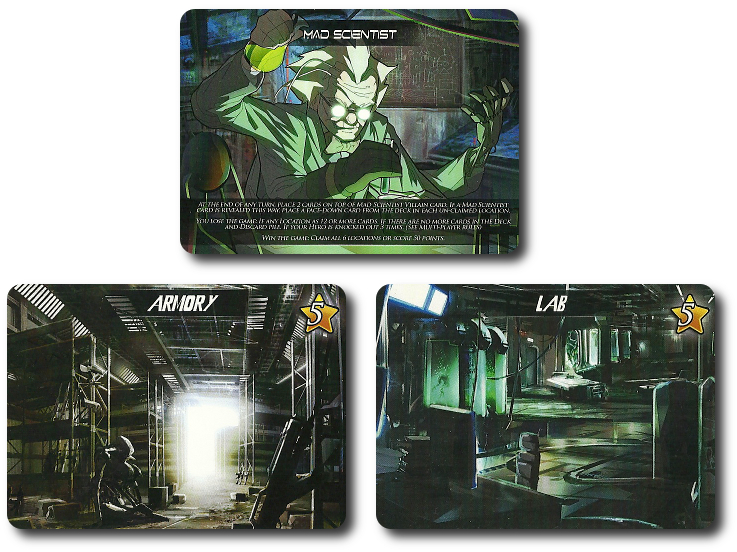
The locations portrayed on the Location cards represent different areas in the abandoned military base. As one team, as a lone soldier, or as cooperative group, the players must make their way to each of these locations, clear them, and claim them. Once claimed, they are secured. Each Location card also has a point value (located in the star symbol) that is used to keep track of a player’s progresses towards victory.
Brave Heroes
A motley crew of professional soldiers and do-good freelancers are set on ending the Mad Scientist’s evil plan or stealing everything out from underneath him. An elite team of Space Troopers, a surefooted Pirate, a talented Engineer, a determined Bounty Hunter, and an inquisitive Scout all have a bone to pick with the Villain. There is no backstory for any of the characters, but the game does invite players to make up their own. Each Character card is unique except for the Space Troopers who are all apparently clones. A player’s Character card lists how many Location columns the player can move their Character token (Movement), the maximum number of damage the character can take before being knocked-out (Shield), and how much equipment the character can use at one time (Equipment).
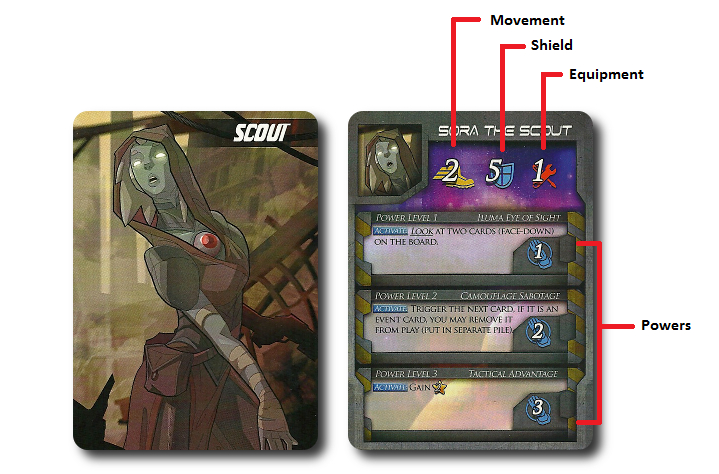
Each Character card also lists Power Levels. Characters start at Power Level Zero, but as the game progresses, they might come across “Power Cell” Encounter cards. These are collected and power up the character. “Power Cell” cards are never lost when the player activates the character’s power, but they can be removed from the character if they are knocked-out or stumble across a trap. To “Activate” a character power, the Character card is tipped during the Trigger step of the player’s turn. Powers can only be activated once per turn as a result.
Equipment and Power Cells
Scattered throughout the different locations are random “Equipment” and “Power Cell” Encounter cards. Sometimes the players will be able to see them since the cards are face-up. Other times, the players will stumble across them blindly.
“Equipment” cards come in two different varieties. These are common and rare. Rare “Equipment” means that the piece is exceptional and one of a kind. Which is not to say the common “Equipment” cards are bogus. They are all useful in their own way. Some will improve the player’s Shield value and some will provide the player the ability to move quickly from one location to another. The maximum number of “Equipment” Encounter cards the player can use at any time during the game is determine by their character’s Equipment value.
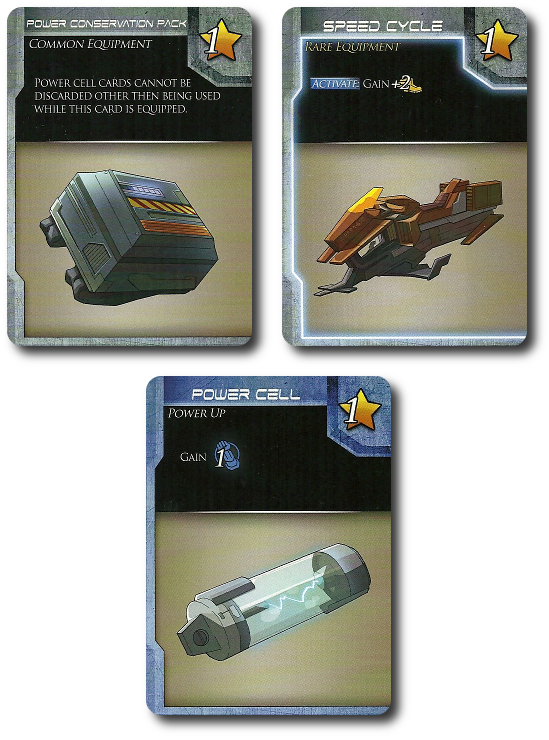
“Power Cell” cards are collected and placed next to the Character card. A player could hold as many as they want, but there is no reason to hold anymore than 3.
Some “Equipment” Encounter cards can be activated for an additional effect. Like the character powers, “Equipment” Encounter cards can only be activated once per turn during the Trigger step.
Traps, Trips, and Trouble
Traps are scattered all over the place and mainly do damage to the player’s character. As long as the total damage inflicted by all the “Trap” Encounter cards found by the player on their turn is less than the character’ Shield value, everything will be fine. However, some “Trap” Encounter cards also have a Trap Effect, which might set off a chain of events that causes a very healthy character to suddenly be very dead.
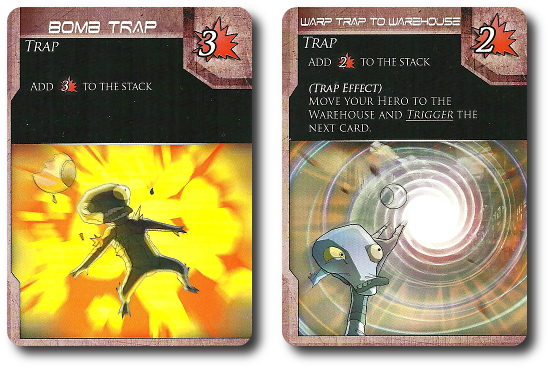
Welcome to the Island
Mad Scientist is played in rounds and turns with no set number of rounds per game. A player’s turn is summarized here.
Note: Mad Scientist can be played several different ways. The game play summarized here is the standard Free for All where all the players are competing against each other. The other modes of play are summarized under the Game Variants section below.
Step 1: Movement
Each Character card has a Movement value. This number indicates how many Location columns the Character token can move left or right of its current column. Movement is always optional and a player is not required to take their full movement. When moving, the Character token is placed underneath the last Encounter card in the Location column. Two or more Character tokens can share the same Location column.
Step 2: Trigger
The player can now optionally pick up the last Encounter card in the Location column, revealing it to all the players. Picking up an Encounter card triggers it. If the Encounter card has any Trigger Effects, they are now resolved, but only if the player is not knocked-out (damage always happens first). All effects are secondary and only occur if the player’s character is still active.
All cards picked up during this step are placed in front of the player in a temporary row. This row is referred to as the player’s “Stack”.
As the player explores, they will run into dangerous situations the will inflict damage on the player’s character. If the total number of Damage points is equal to or greater than the character’s Shield points, they are knocked-out. Each player is only given 3 “Knockouts” by default. If they are knocked-out 3 times, they are out of the game. When the player’s character is knocked-out, all the cards in player’s Stack, Equipment cards on the Character cards, and Power Cell cards are discarded. The player’s turn is now over and they skip to step 4.
A player can continue to pick up Encounter cards if they like, but only at the Location column they are currently occupying. If the player’s last card in the column is a Location card, they can pick it up, too. This secures the Location and ensures the Mad Scientist won’t b able to use it. When the player decides to stop or secures the Location card, the next step can begin.
Step 3: Salvage
The player now totals the star points on all the cards they collected during their turn. The number is added to the player’s total points earned so far.
From the cards they collected, they may now swap out and upgrade their Equipment and attached Power Cells. The maximum number of “Equipment” Encounter cards that can be attached to a character is defined by the Character card’s Equipment value. Any cards not attached are discarded.
Step 4: Mad Scientist
The last thing a character does is draw 2 Encounter cards, revealing them 1 at a time. If the “Mad Scientist” Encounter card is revealed, place 1 face-down Encounter card in every Location column not yet secured by the players.
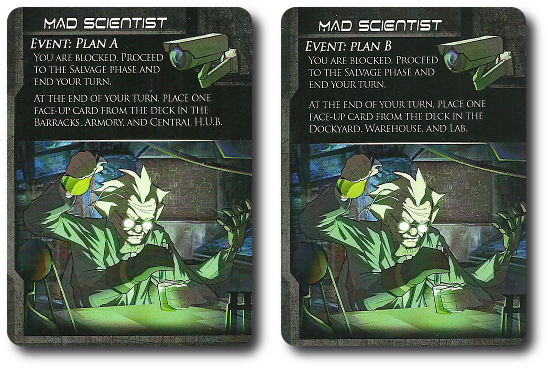
This concludes the player’s turn. It’s now the next player’s turn starting with step 1 above.
Winning and Losing the Game
The game ends in the players’ favor when all 6 Locations are secured or 1 player earns 50 points.
The game is lost if any unclaimed Location columns have 12 or more Encounter cards, all player characters have used their 3 knocked-outs, or if there are no more cards in the face-down Encounter deck.
Game Variants
Modifying Your Mission
The number and type of Encounter cards can be modified by the player if they want to tailor their gaming experience. For example, there are 5 “Rare Equipment” Encounter cards in the game. The player could decide that this adventure only has 1 and removes the other 4. A whole new story can now be built around this 1 piece of rare equipment, providing the players an opportunity to create a new victory condition.
Adjusting Difficulty
For Solitaire and Cooperative games, the level of difficulty can be modified by reducing or increasing the number of “Mad Scientist” Encounter cards and the number of Knockouts.
Going Solo
Mad Scientist can be played as a solitaire game very easily. Simply set up the game as normal and play as one or more Characters. The challenge is surviving and seeing how big a score the player can obtain. Adjust difficulty as required.
Cooperative Assault
Mad Scientist can also be played as a cooperative game, where each player will win only if the team wins. By default, all the players are sharing a maximum number of 3 Knockouts, but this can be increased for an easier game.
Team Play
This plays exactly like the Free for All and Cooperative game modes described above, but the players are grouped into even-numbered teams. Victory is shared between the team members and all members of the team share 3 Knockouts.
To learn more about Mad Scientist, visit the game’s website.
Final Word
The Child Geeks enjoyed themselves. They liked “exploring” the different locations and raced to specific ones when a face-up Encounter card was available. The favorite game mode was by far the Cooperative game play. Working together let the Child Geeks provide helpful advice, warn players “not to reveal the next card”, and enjoy the challenge of the game together. There was some frustration at first when it seemed that some players were getting better cards than others, but it later became obvious to all that the cards were randomly distributed fairly (which is a silly statement). According to one Child Geek, “This is a pretty simple game. The hardest thing to think about is which piece of equipment to keep and if you should keep pushing your luck to secure a location.” Another Child Geek said, “I wish I knew more about my character and why the Mad Scientist is mad, but I guess that’s not important to the game.” No, it isn’t, but it does feel like something that should be in the game. The only aspect of the game play the player’s didn’t much care for was the limiting of “Equipment” Encounter cards. Everyone thought, for example, that the Space Trooper characters should be able to carry more than a single piece of equipment. That being said, all the Child Geeks loved leveling up their characters in the game. “POWER UP!” was a phrase many of them yelled when a “Power Cell” Encounter card was found. When the Mad Scientist was safely behind bars, all the Child Geeks voted to approve Mad Scientist.
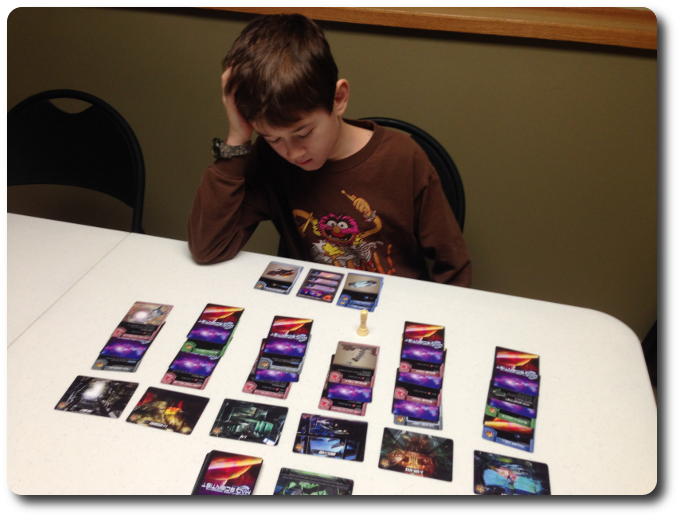
My oldest little geek contemplates his next move during a solo game
The Parent Geeks liked the game’s concept and found it to be a unique game playing experience. Even the non-gamers understood what the game was about and how it should be played. According to one Parent Geek, “I like this. Its use of risk versus reward is like nothing I’ve ever seen before.” But the game started to get stale for the Parent Geeks. One bored Parent Geek said, “This is a pretty fast game, but all I’m doing is flipping over cards. Feels a bit like reverse Solitaire at times or Minesweeper.” As the games went on, the Parent Geeks started to fall into two groups. One group found Mad Scientist to be an entertaining card game full of light but interesting decisions that emphasized risk versus reward. The other group started to see the game as nothing more than flipping over cards, doing something with them, and then moving on. The end result was a mixed bag from the Parent Geeks resulting in a mixed endorsement.
The Gamer Geeks were not overly impressed with the game. According to one Gamer Geek, “What risk is there? If your character is hurt, you just stop. Duh.” Another Gamer Geek said, “If you just keep working on this game at a faster pace than the game can slow you down, you’ve got it made.” We attempted to make the game more difficult, but the Gamer Geeks compensated by pushing just a bit harder, winning every time. In fact, they never lost a game which lead them to believe the game provided little in the way of challenge. All the Gamer Geeks thought the idea of the game was an interesting one and liked all the possibilities it promised. They became rather disgruntled when the game didn’t deliver. One Gamer Geek said, “This game is empty. I don’t find it challenging, I don’t find it fun, and I don’t find it interesting to just flip over cards.” All the Gamer Geeks voted to reject Mad Scientist.
Game-wise, I found Mad Scientist to be so-so. What little information there is in the Location columns serves to entice the players to take risks, but the level of risk and reward is always the same. The only way a player can manage the hidden doom and not blow their character to smithereens is to continue forward at a reasonable pace or just end their turn. That’s surprisingly easy, making the game an exercise in restraint more than anything else. Flipping over multiple face-down Encounter cards feels risky, but no more so than flipping over 1 face-down card.
Thematically, the game falls short. I would have liked to have seen more thematic elements that reinforced the game’s narrative. The provided rule book briefly explains what is going on and why there is such a strange mix of characters, but if you fail to read it, you have no idea what the game is about. Not that it matters, since there is nothing in the game that allows players to take the fight to the Mad Scientist. Players win by essentially taking over all the places the Mad Scientist hangs out or scoring a specific number of points.
At this time, I wouldn’t recommend the game. The parts are all there, but they haven’t come together. The rules are all over the place, the text is too small at times to easily read, and there were too many questions being asked by players that the game could not answer. To me, that means the game isn’t done. On the bright side, I don’t think it would take much to get this game back on track. A better rule book is an absolute must. I had to read 1 rule book, 3 Rule cards, and a website to figure out how to play the game. That, my friends, is ridiculous. The card text also needs to be addressed. I’m going to guess that they are using 8 point font which means only ants can read it. Finally, the game needs to be presented in a way that makes it feel like it’s more than just a collection of cards. There is a story here and it can easily be supported by the game’s theme and narrative that is crying to be heard. Everything else is fine. The different game playing modes are easy to use, adjusting difficulty is simple, and the games are fast.
In the end, the game’s rough edges make it a bit too difficult to play and enjoy.
This game was given to Father Geek as a review copy. Father Geek was not paid, bribed, wined, dined, or threatened in vain hopes of influencing this review. Such is the statuesque and legendary integrity of Father Geek.



